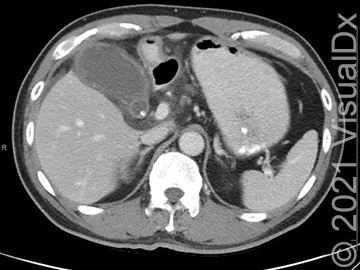Zachary R, an internal medicine resident at the University of Arizona, uses the VisualDx differential builder to diagnoses patient with atypical presentation of a potentially life-threatening condition.
“An elderly male patient presented to our ED complaining of diffuse abdominal pain with increased pain in his RLQ. He stated that the pain started about 1 week ago and has gotten progressively worse. My patient believed it was because he hadn’t had a good bowel movement for 4-5 days, and was denying any fever, chills, chest pain, or shortness of breath. Physical exam was notable for a slightly distended abdomen, although the patient was obese, mildly tender to palpation in all quadrants without increased tenderness in the RL or RUQ.
“I asked my intern to run through a differential, and we used VisualDx to suggest some differential diagnoses. My intern had not thought of acute cholecystitis as a possible diagnosis, but it was one of the first on VisualDx. After CT we diagnosed the patient with cholecystitis—nailing the diagnosis.”
What is cholecystitis?
Acute cholecystitis is a clinical syndrome that is associated with gallbladder wall inflammation and characterized by right-upper-quadrant (RUQ) abdominal pain, fever, and leukocytosis. Acute cholecystitis and cholangitis are 2 of the 3 main emergencies of the biliary tract and can be life-threatening if appropriate treatment is not initiated promptly.
What should we be aware of when making a diagnosis?
Murphy’s sign:
- Place hand firmly at costal margin in mid-clavicular line of RUQ, and ask patient to breathe deeply.
- If the gallbladder is inflamed, patient will experience pain and catch their breath as the gallbladder descends and comes into contact with palpating hand.
- Sonographic Murphy’s sign is elicited by visualizing the gallbladder and pushing on it with the ultrasound probe.
How can we treat this?
- Laparoscopic cholecystectomy for acute calculous cholecystitis is the preferred therapy early in hospitalization.
- Antibiotics are clearly indicated in patients with complicated cholecystitis such as emphysematous, gangrenous, or perforated cholecystitis.
Subscribe to VisualDx Today
Become a VisualDx subscriber today and gain access to clinical information and medical images of thousands of diagnoses. Your first 7 days are FREE.
